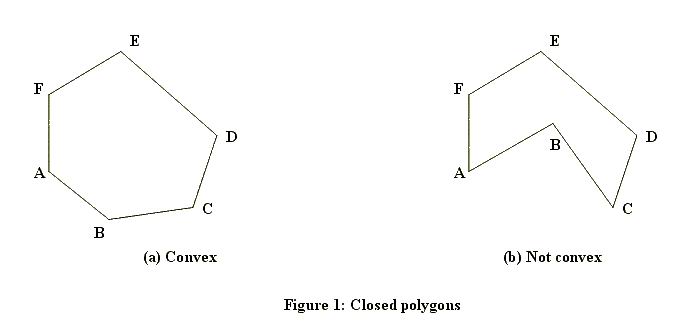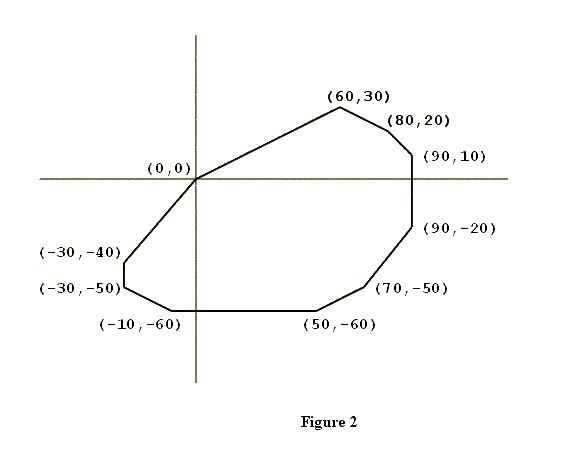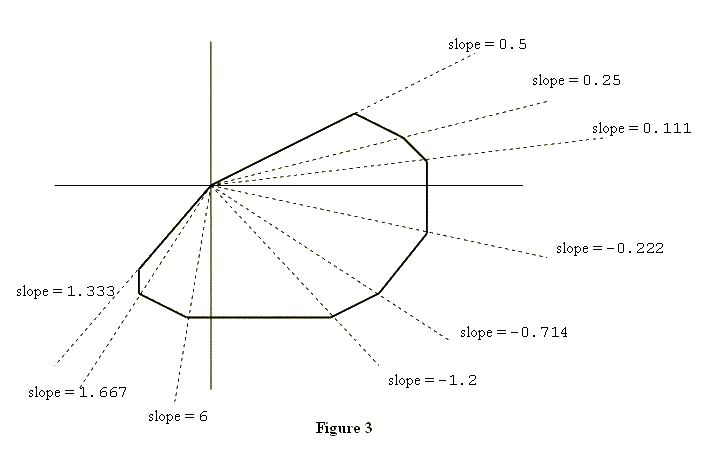POJ 2007--Scrambled Polygon(计算凸包,点集顺序)
| Time Limit: 1000MS | Memory Limit: 30000K | |
| Total Submissions: 10094 | Accepted: 4765 |
Description
A closed polygon is called convex if the line segment joining any two points of the polygon lies in the polygon. Figure 1 shows a closed polygon which is convex and one which is not convex. (Informally, a closed polygon is convex if its border doesn't have any "dents".) 
The subject of this problem is a closed convex polygon in the coordinate plane, one of whose vertices is the origin (x = 0, y = 0). Figure 2 shows an example. Such a polygon will have two properties significant for this problem.
The first property is that the vertices of the polygon will be confined to three or fewer of the four quadrants of the coordinate plane. In the example shown in Figure 2, none of the vertices are in the second quadrant (where x < 0, y > 0).
To describe the second property, suppose you "take a trip" around the polygon: start at (0, 0), visit all other vertices exactly once, and arrive at (0, 0). As you visit each vertex (other than (0, 0)), draw the diagonal that connects the current vertex with (0, 0), and calculate the slope of this diagonal. Then, within each quadrant, the slopes of these diagonals will form a decreasing or increasing sequence of numbers, i.e., they will be sorted. Figure 3 illustrates this point. 

Input
Output
Sample Input
0 0
70 -50
60 30
-30 -50
80 20
50 -60
90 -20
-30 -40
-10 -60
90 10
Sample Output
(0,0)
(-30,-40)
(-30,-50)
(-10,-60)
(50,-60)
(70,-50)
(90,-20)
(90,10)
(80,20)
(60,30)
Source
#include<iostream>
#include<algorithm>
#include<cmath>
#include<cstdio>
using namespace std;
const int maxn = ;
typedef struct point {
double x, y;
point() { }
point(double a, double b) {
x = a;
y = b;
}
point operator -(const point &b) const{
return point(x - b.x, y - b.x);
}
double operator *(const point &b)const {
return x*b.x + y*b.y;
}
}point;
point p[maxn];
int n=, res[maxn];
int top;//top模拟栈顶
bool cmp(point a, point b) {
if (a.y == b.y) return a.x < b.x;
return a.y < b.y;
}
bool multi(point p1, point p2, point p0) { //判断p1p0和p2p0的关系,<0,p1p0在p2p0的逆时针方向,>0,p1p0在p2p0的顺时针方向
return (p1.x - p0.x)*(p2.y - p0.y) >= (p2.x - p0.x)*(p1.y - p0.y);
}
void Graham(){
int i, len;//top模拟栈顶
sort(p, p + n, cmp);
top = ;
//少于3个点也就没有办法形成凸包
if (n == )return; res[] = ;
if (n == )return; res[] = ;
if (n == )return; res[] = ;
for (i = ; i < n; i++) {
while (top&&multi(p[i], p[res[top]], p[res[top - ]])) //如果当前这个点和栈顶两个点构成折线右拐了,就回溯到上一个点
top--; //弹出栈顶
res[++top] = i; //否则将这个点入栈
}
len = top;
res[++top] = n - ;
for (i = n - ; i >= ; i--) {
while (top!=len&&multi(p[i], p[res[top]], p[res[top - ]]))
top--;
res[++top] = i;
}
}
int main(void) {
int i, s;//s为起点坐标
while (scanf("%lf%lf", &p[n].x, &p[n].y)!=EOF)n++;
Graham();
for (s = ; s < top; s++) {
if (!p[res[s]].x && !p[res[s]].y) //找到原点
break;
}
for (i = s; i < top; i++) {
printf("(%.lf,%.lf)\n",p[res[i]].x, p[res[i]].y);
}
for (i = ; i < s; i++) {
printf("(%.lf,%.lf)\n", p[res[i]].x, p[res[i]].y);
}
return ;
}
POJ 2007--Scrambled Polygon(计算凸包,点集顺序)的更多相关文章
- POJ 2007 Scrambled Polygon 凸包
Scrambled Polygon Time Limit: 1000MS Memory Limit: 30000K Total Submissions: 7214 Accepted: 3445 ...
- POJ 2007 Scrambled Polygon [凸包 极角排序]
Scrambled Polygon Time Limit: 1000MS Memory Limit: 30000K Total Submissions: 8636 Accepted: 4105 ...
- POJ 2007 Scrambled Polygon 极角序 水
LINK 题意:给出一个简单多边形,按极角序输出其坐标. 思路:水题.对任意两点求叉积正负判断相对位置,为0则按长度排序 /** @Date : 2017-07-13 16:46:17 * @File ...
- POJ 2007 Scrambled Polygon 凸包点排序逆时针输出
题意:如题 用Graham,直接就能得到逆时针的凸包,找到原点输出就行了,赤果果的水题- 代码: /* * Author: illuz <iilluzen[at]gmail.com> * ...
- poj 2007 Scrambled Polygon(极角排序)
http://poj.org/problem?id=2007 Time Limit: 1000MS Memory Limit: 30000K Total Submissions: 6701 A ...
- ●POJ 2007 Scrambled Polygon
题链: http://poj.org/problem?id=2007 题解: 计算几何,极角排序 按样例来说,应该就是要把凸包上的i点按 第三像限-第四像限-第一像限-第二像限 的顺序输出. 按 叉积 ...
- 简单几何(极角排序) POJ 2007 Scrambled Polygon
题目传送门 题意:裸的对原点的极角排序,凸包貌似不行. /************************************************ * Author :Running_Time ...
- POJ 2007 Scrambled Polygon(简单极角排序)
水题,根本不用凸包,就是一简单的极角排序. 叉乘<0,逆时针. #include <iostream> #include <cstdio> #include <cs ...
- POJ 2007 Scrambled Polygon (简单极角排序)
题目链接 题意 : 对输入的点极角排序 思路 : 极角排序方法 #include <iostream> #include <cmath> #include <stdio. ...
- poj 2007 Scrambled Polygon 极角排序
/** 极角排序输出,,, 主要atan2(y,x) 容易失精度,,用 bool cmp(point a,point b){ 5 if(cross(a-tmp,b-tmp)>0) 6 retur ...
随机推荐
- 软件项目技术点(2)——Canvas之平移translate、旋转rotate、缩放scale
AxeSlide软件项目梳理 canvas绘图系列知识点整理 画布操作介绍 画布绘图的环境通过translate(),scale(),rotate(), setTransform()和transf ...
- centOs升级
因为军佬放弃制作Centos7的网络重装包,又Centos7的安装引导和6有较大区别所以,选择曲线救国(技术不行,只能这样乱搞)前文:Centos6.9一键重装包https://ppx.ink/net ...
- Don't forget, a person's greatest emotional need is to feel appreciated.
Don't forget, a person's greatest emotional need is to feel appreciated.莫忘记,人类情感上最大的需要是感恩.
- Elipse plugin or Bundle & OSGI
Develop and register service, lookup and use service! Android Design on service's publish-find-bind ...
- 【Linux】Linux 在线安装yum
Linux如何安装软件? 一.RPM安装 优点: 安装过程很简单 缺点: 需要自己寻找和系统版本对应的RPM包 安装过程中需要解决包的依赖问题(例如tftp包) 二.yum在线安装 软件包仓库 仓库的 ...
- Jmeter性能测试 入门--转载
转载: Jmeter性能测试 入门 Jmeter是一款优秀的开源测试工具, 是每个资深测试工程师,必须掌握的测试工具,熟练使用Jmeter能大大提高工作效率. 熟练使用Jmeter后, 能用Jmete ...
- matlab练习程序(随机游走图像)
随机游走类似布朗运动,就是随机的向各个方向走吧. 虽然代码没什么技术含量,不过产生的图像实在太漂亮了,所以还是贴上来吧. 产生的图像: matlab代码如下: clear all;close all; ...
- check_mk的性能案例
http://wiki.lustre.org/Check_MK/Graphite/Graphios_Setup_Guide Dell PowerEdge R515 2x 8-Core AMD Opte ...
- RedHat 6.4源码方式安装mysql5.5
参考文档:http://dev.mysql.com/downloads/file/?id=463397 下载地址http://dev.mysql.com/doc/refman/5.7/en/ 文档地址 ...
- March 8 2017 Week 10 Wednesday
Rules are meant to be broken. 规则就是用来被打破的. What is innovation? Some may tell you innovation is to bre ...
